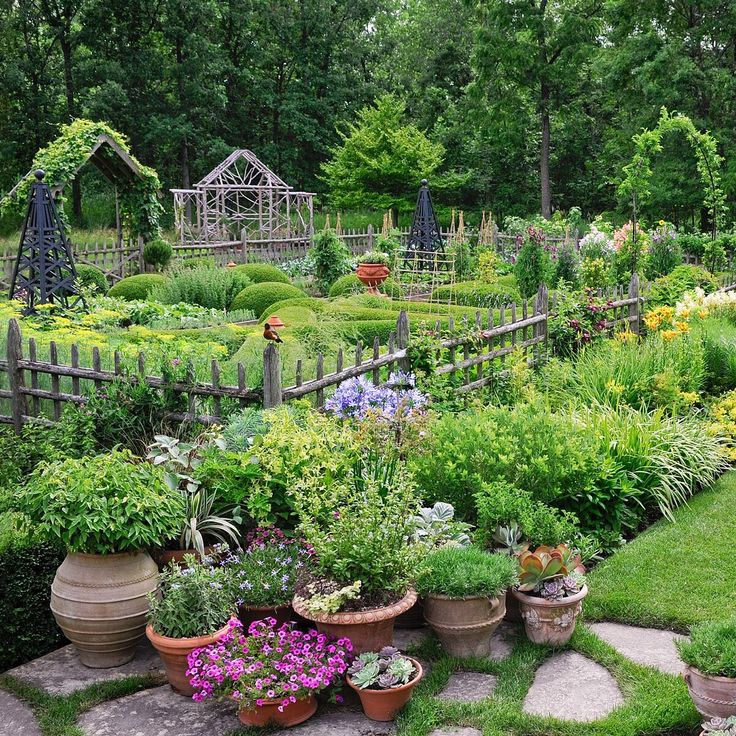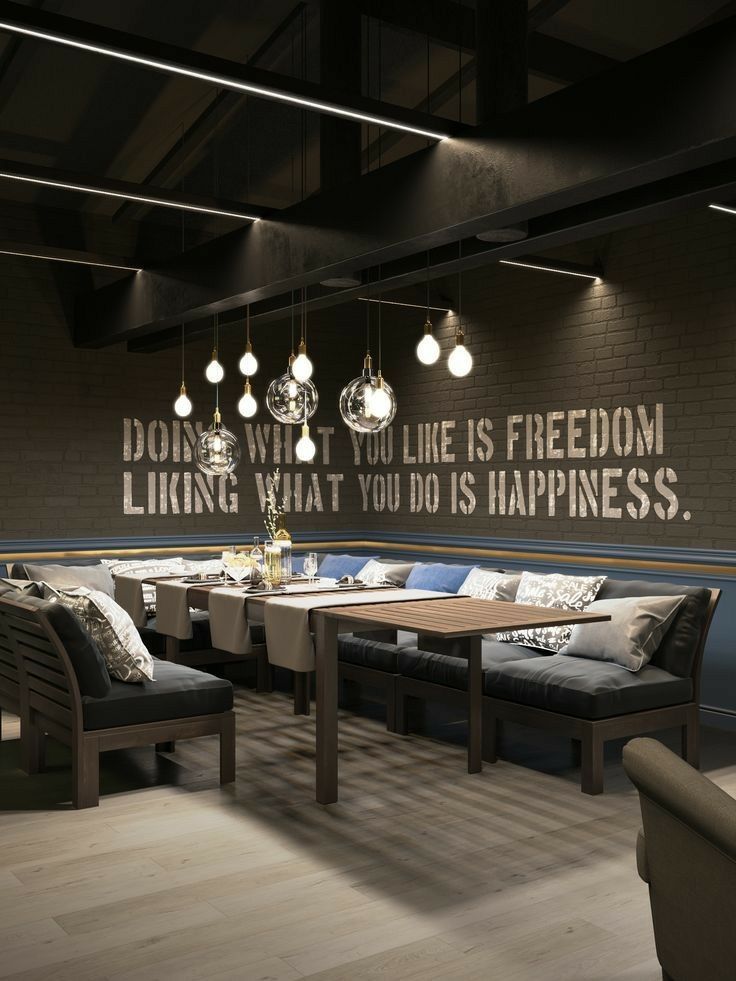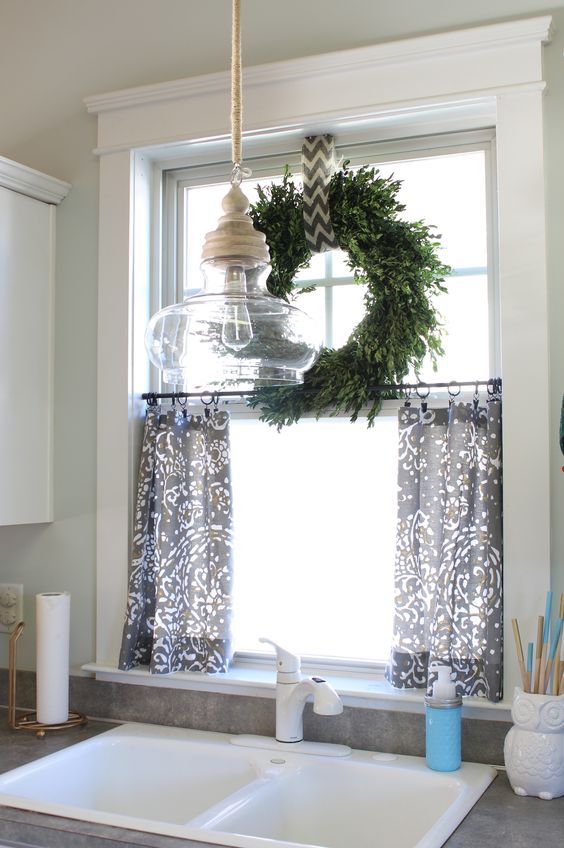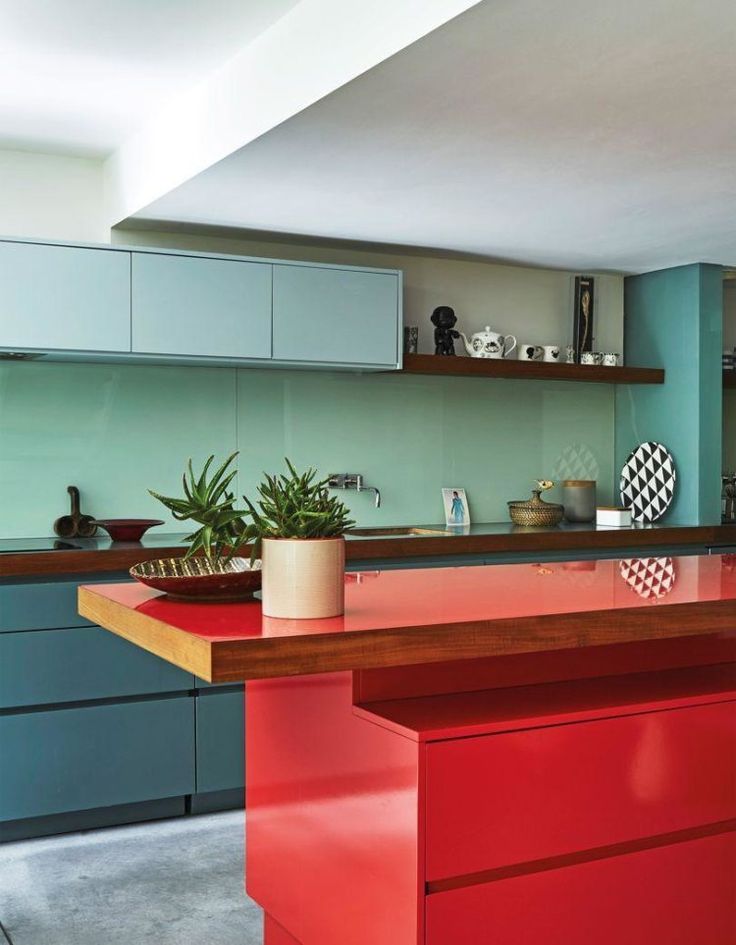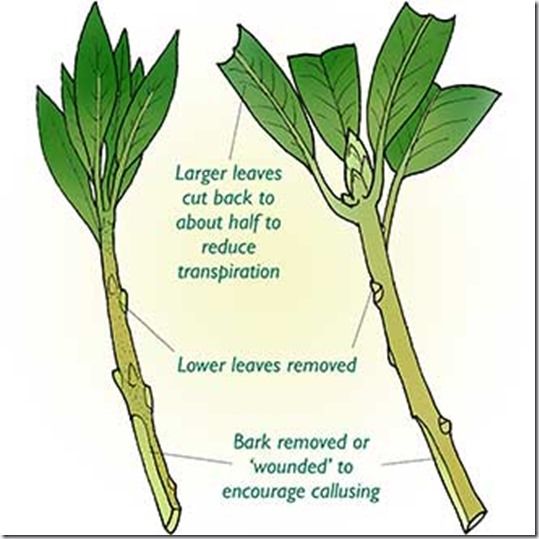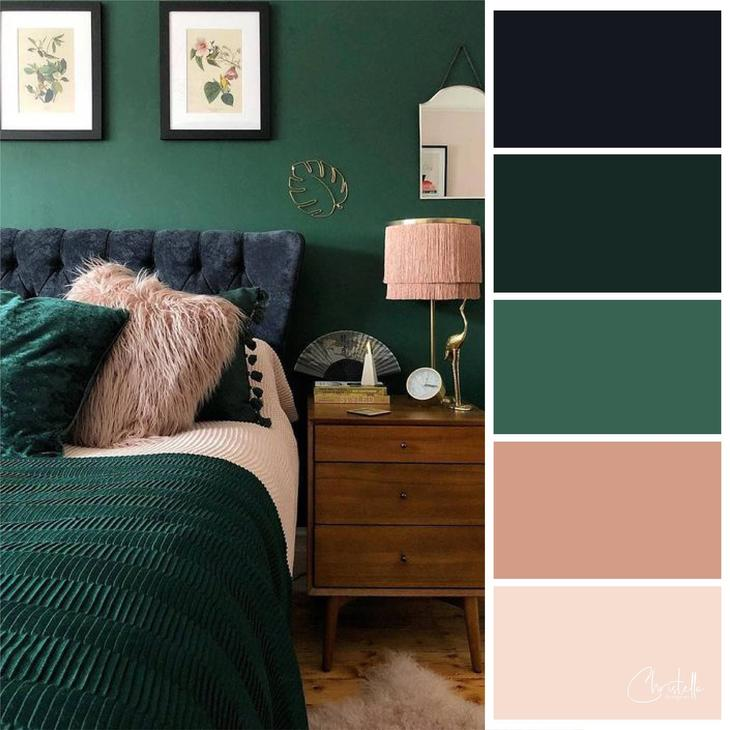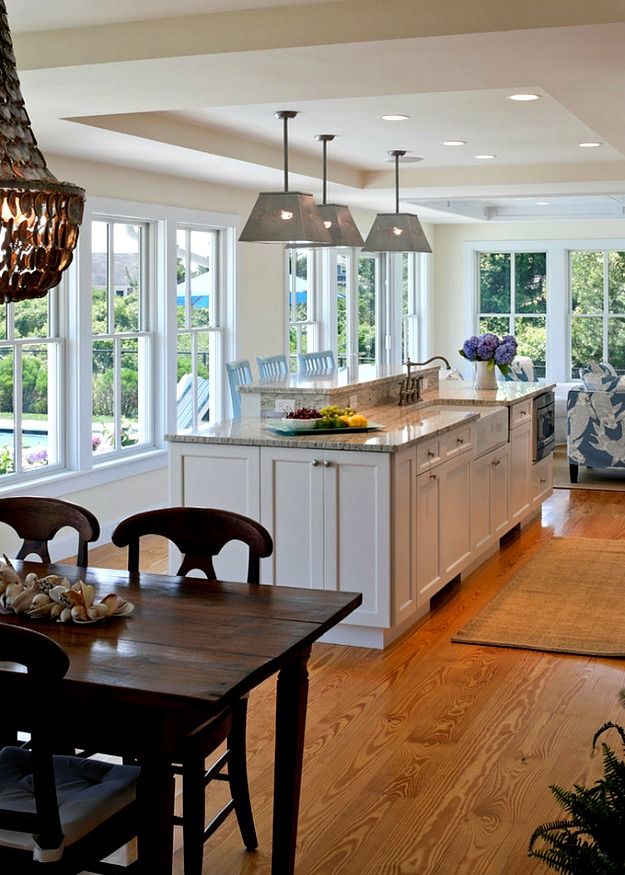What to do with a steep backyard
What To Do With a Sloping Backyard
Skip to contentPrevious Next
- View Larger Image
So you’ve decided it’s time to build a custom home with a beautiful view — are you concerned about what building on a slope would mean for your backyard?
Designing a sloping backyard certainly presents its own challenges, including:
- Slopes can be difficult to walk on
- Landscaping on slopes can be difficult to maintain
- If done incorrectly, you run the risk of soil erosion and water drainage problems
However, a sloping backyard also presents a unique opportunity to show off that beautiful view you’ve been hoping for, and create a unique sense of movement and variation in your landscape.
Here are 10 things to do with a sloping backyard.
1. Determine the surface texture of your soil
The first thing we recommend when considering what to do with a sloping backyard is to determine the surface texture of the soil you’re working with. In fact, this is a good thing to consider before building on a slope at all, as it will directly impact your foundation and your landscaping capabilities.
The surface texture of the soil refers to the amount of clay, sand, and silt present in your soil. To get an idea of the surface texture, simply rub the soil between your hands and note what you feel.
Silky clay texture – This type of soil is difficult to work with from a foundational and landscaping perspective. It’s characterized by feeling soft and sticky when wet, but very hard when dry.
Floury-feeling – This soil feels like exactly what its name implies — floury. It is ideal for landscaping and gardening, and is very easy to excavate.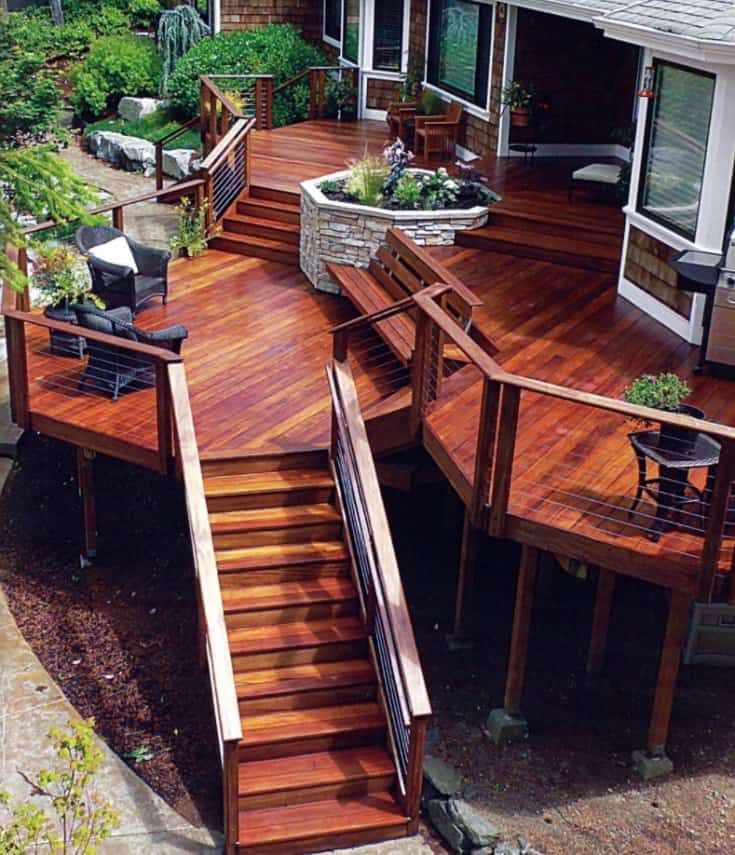
Rough and gritty – Although this kind of soil is easy to excavate, it also poses an increased risk of soil erosion. Rough and gritty soil often needs moisture improvement before it can be used for gardening or landscaping.
2. Build a deck
Coming back to that beautiful view we’ve been talking about, incorporating a deck into your home design creates the perfect opportunity to entertain and show it off, or to put your gardening and landscaping on display. Depending on the angle of the slope and the overall design of the house, you can even make a multi-level deck, or create a storage space underneath.
3. Try landscaping in tiers
Not only does creating tiers help manage erosion, it provides a unique opportunity to add variety and cohesion to your backyard, depending on how you choose to showcase different plants. Another plus? The tiers can be made from a number of different materials, including wood, paving stones, brick, and concrete, providing you more variety when it comes to choosing the look and feel of your backyard.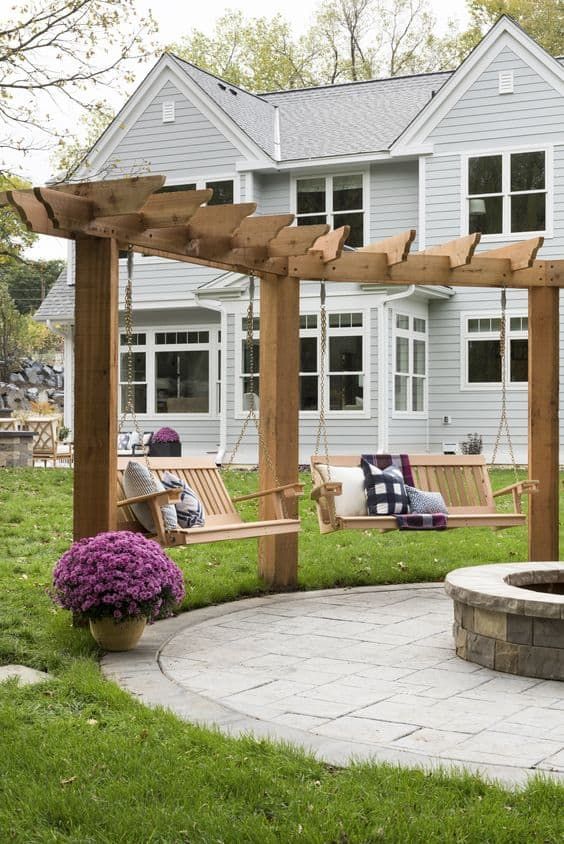
Depending on the slope of your yard and the height of your tiers, you may need to install railing for safety if you choose this route — our team at Westlake Development always adheres to correct building codes.
4. Create a winding path or a staircase
Adding a path or staircase to your backyard helps with multiple things, including:
- Drawing the eye through the yard
- Making it easier to move throughout the yard
- Providing a safe way to use the yard
5. Consider a landscape waterfall
This is a larger undertaking, but also the perfect opportunity to showcase a beautiful water feature in your backyard, and use a slope to your advantage. Not only do waterfalls add value to your home and provide great entertainment for family and friends, they also benefit your local ecosystem and create a relaxing, soothing environment.
6. Use the slope to your advantage when building vegetable beds
Planting a garden on a slope can be challenging with soil erosion remaining a large concern. However, one great option is creating raised vegetable beds that match the slope of the backyard. Not only will this make it easier to care for the garden, but it will also allow you to use the slope to your advantage — the deeper area of the bed can be used for root vegetables, while the more shallow area can house herbs.
However, one great option is creating raised vegetable beds that match the slope of the backyard. Not only will this make it easier to care for the garden, but it will also allow you to use the slope to your advantage — the deeper area of the bed can be used for root vegetables, while the more shallow area can house herbs.
7. Create a destination at the bottom of the slope
Help draw friends, family, visitors through your backyard and showcase the landscape by creating a fun destination at the bottom of the slope. This could be a fire pit, a gazebo, a flat seating area to take in a view or a deck perfect for BBQs…the sky’s the limit.
8. Choose low maintenance plants and be strategic about rock placement
Plants are a great way to transform a backyard and keep soil from sliding down a slope. When choosing plants for your sloping backyard, you’ll want to consider a few things:
- The kind of soil you’re using
- How easy they’ll be to reach
- How easy they’ll be to care for
When it comes to plants and shrubs in Oregon, wild roses, Snowberry, Oceanspray and Red Flowering Currant are all recommended options.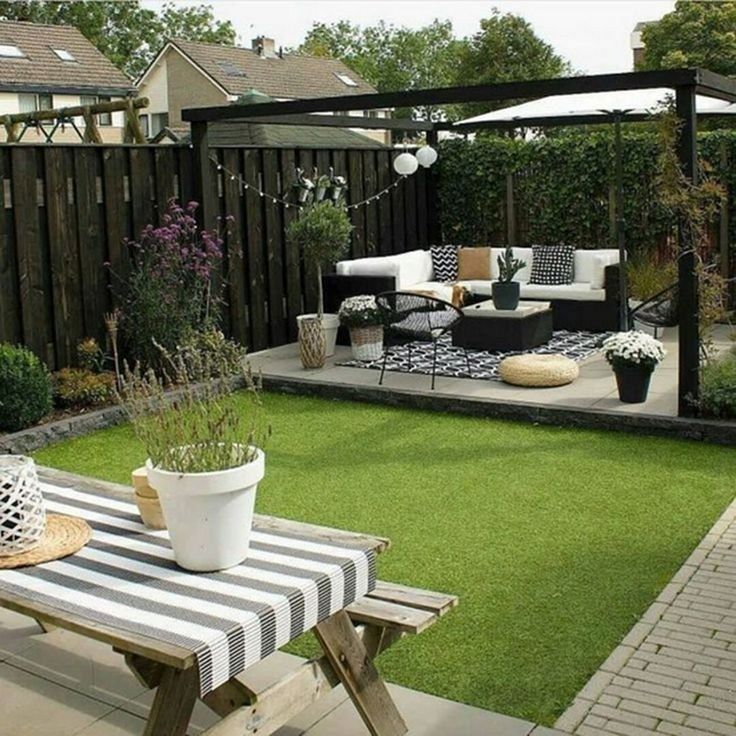 Ground cover plants are also a great and easy to maintain option. Silverweed, Kinnikinnick, and Coastal Strawberry are some native options to look into.
Ground cover plants are also a great and easy to maintain option. Silverweed, Kinnikinnick, and Coastal Strawberry are some native options to look into.
Adding rocks of varying shapes and sizes to your garden helps create a more stable area for plants to grow, plus look great too.
9. Create flat spaces with retaining walls
One challenge presented by sloping backyards is creating functional areas despite the slope’s angle. Carving out part of the slope and adding a retaining wall to hold back the soil will allow you to create a flat area in your backyard. These can create planting areas, seating areas, or recreational areas for the family.
10. Make it easy to access all of the levels
If you’re planning to spend a lot of time in your backyard and use it for entertaining or gardening, we recommend being conscious of the type of access you have to all levels of your backyard. For example, you wouldn’t want to build vegetable beds or plant roses without an easy path to get there and care for those things, right? Whether through a winding path, a staircase, or level tiers, we’ll ensure you have a way to get everywhere you need to be in your backyard.
Contact Westlake Development today
Building a home on a slope can be challenging and stressful — but when you choose the right custom home builder, it doesn’t need to be.
At Westlake Development Group, we’ve been building custom homes in the Portland metro area for more than 30 years, and take pride not only in creating beautiful designs, but in providing steep slope construction and earthquake preparedness expertise.
To learn more about how we can help you build the custom home you’ve been looking for, contact us today at (503) 327-8351 or online here.
About the Author: westlake
Page load linkGo to Top
Backyard Slope Landscaping Ideas - 10 Things To Do
Break Out in Tiers
1/11
Creating several tiers on a sloped property can help manage erosion and give you the opportunity to layer different plants and landscaping elements for a cohesive design.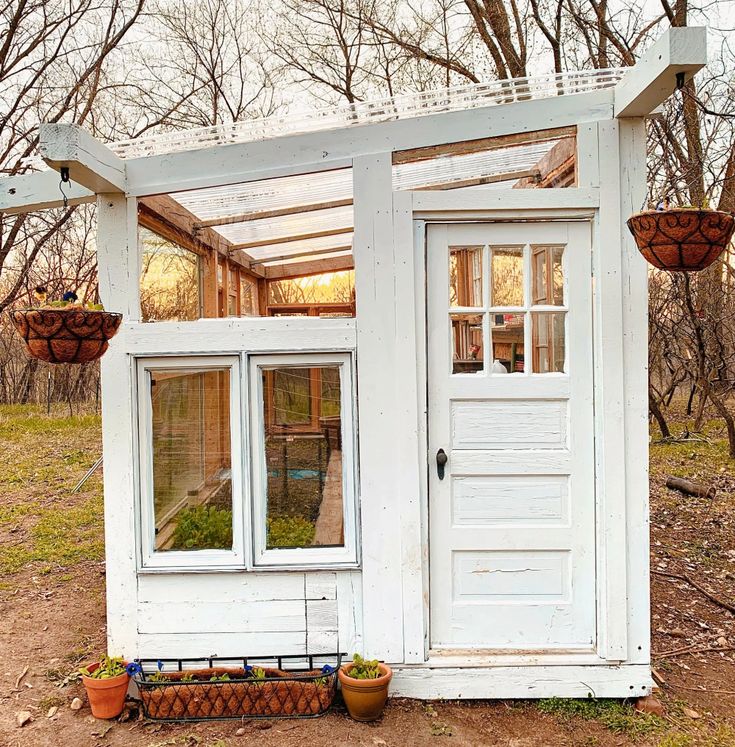 Whether you use railroad ties, stone pavers, or concrete to form the tiers, they will make a dramatic impact on the overall look of your property.
Whether you use railroad ties, stone pavers, or concrete to form the tiers, they will make a dramatic impact on the overall look of your property.
Related: 9 Clever Landscaping Hacks for Your Best-Ever Yard
istockphoto.com
Build Some Stairs
2/11
If you choose to let vegetation cover your sloping property in glorious abandon, impose a little order by building a set of stairs leading up to flatter ground. Whether you opt for a wooden staircase or concrete steps, this garden feature will blend into the landscape far better if it’s surrounded by plantings on either side.
Related: 12 Perfect Plants for Lining Your Pathway
istockphoto.com
Make a Natural Staircase
3/11
Use a natural material like stone to create a stepped pathway through your sloping property. A stone stairway will complement surrounding plantings and help anchor your landscaping design.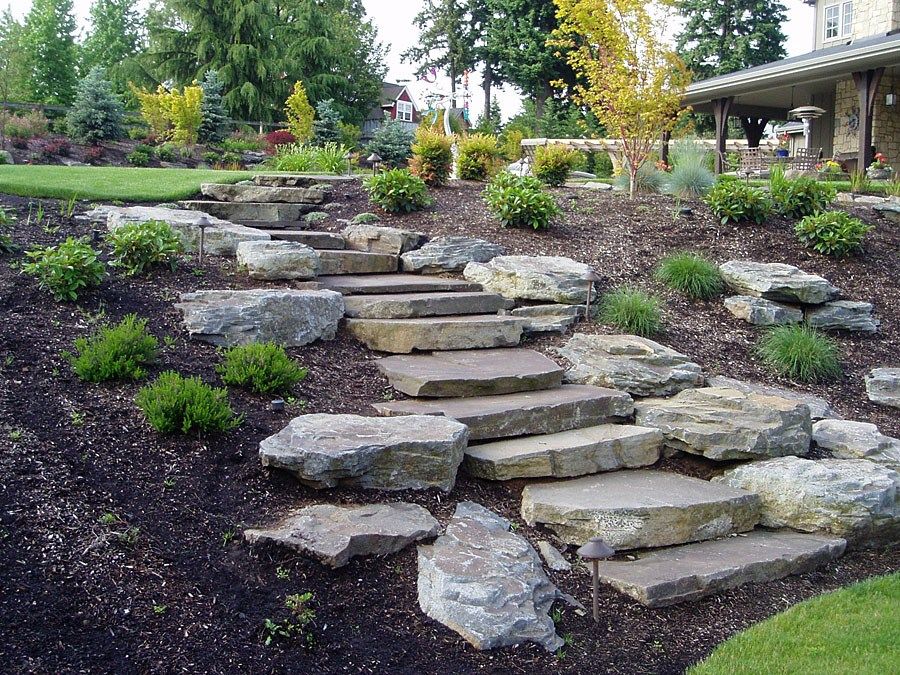
Related: 7 Thrifty Designs for a DIY Walkway
istockphoto.com
Design a Waterfall
4/11
If you’re ambitious, use the height that your hilly backyard provides to your advantage, and build a sensational water feature. The soothing sound of water will bring a relaxing air to your outdoor space, turning it into your own private oasis.
Related: 10 Outdoor Living Ideas to Steal from California
istockphoto.com
Lay a Winding Path
5/11
A winding or switchback path can make it much easier—and safer—to explore a sloped piece of property. A meandering pathway also provides an attractive focal point and draws the eye through the landscape.
Related: 10 Inspiring Ideas for Your Side Yard
istockphoto.com
Erect a Retaining Wall
6/11
You can make a sloping property more functional by cutting away a portion of a hill and installing a retaining wall to hold back the soil.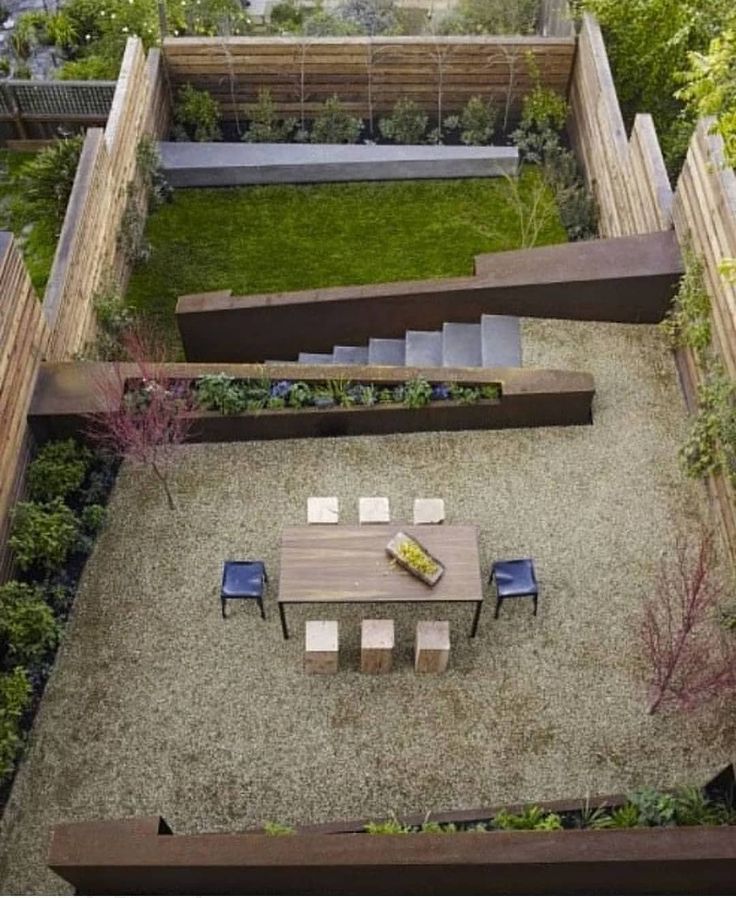 This is a great opportunity to create a dedicated planting area behind and along the retaining wall, while reclaiming a portion of your yard for an expanse of grass on level ground.
This is a great opportunity to create a dedicated planting area behind and along the retaining wall, while reclaiming a portion of your yard for an expanse of grass on level ground.
Related: Edge Your Beds: 11 Easy Ideas for Landscape Borders
istockphoto.com
Cultivate a Rock Garden
7/11
Hillsides can pose a landscaping challenge for plants, which can suffer from the soil erosion or poor drainage typical of sloping properties. When you arrange rocks of varying shapes and sizes on your hillside, you create a stable base for rock-loving plants like stonecrop, ornamental grasses, and creeping ground covers. A rock garden looks lush and satisfying to the eye, and reduces your maintenance load in the yard.
Related: 25 Plants for Your Easiest Garden Ever
istockphoto.com
Devise a Destination Fire Pit
8/11
Building hardscapes into a sloping property is a common and rewarding landscaping practice.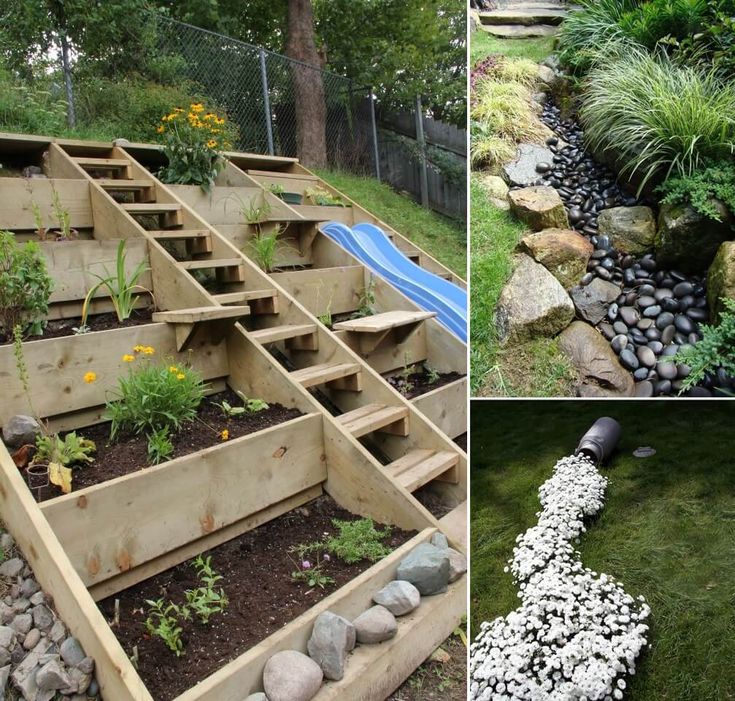 When a design culminates in an alluring destination like a fire pit, you’ll draw visitors through your yard and transform what might otherwise be neglected space into the place to be.
When a design culminates in an alluring destination like a fire pit, you’ll draw visitors through your yard and transform what might otherwise be neglected space into the place to be.
Related: No Money to Burn? 9 Fire Pits You Can Afford
istockphoto.com
Install Veggie Beds
9/11
You can take advantage of unused real estate on a slope that gets full sun by installing raised beds for vegetables. Deeper sections of the beds can be used for root vegetables that require more soil, and the shallower portions will be perfect for herbs and vining plants.
Related: 13 Creative Designs for Easy DIY Planters
istockphoto.com
Rely on Native Plants
10/11
Festooning a hillside with plants that are native to your area can help make maintenance easier in a spot that would be difficult to mow and landscape. With native plants, you can be fairly certain that they’ll be successful without much help from you, and they will help reduce erosion by providing a network of roots to hold soil in place.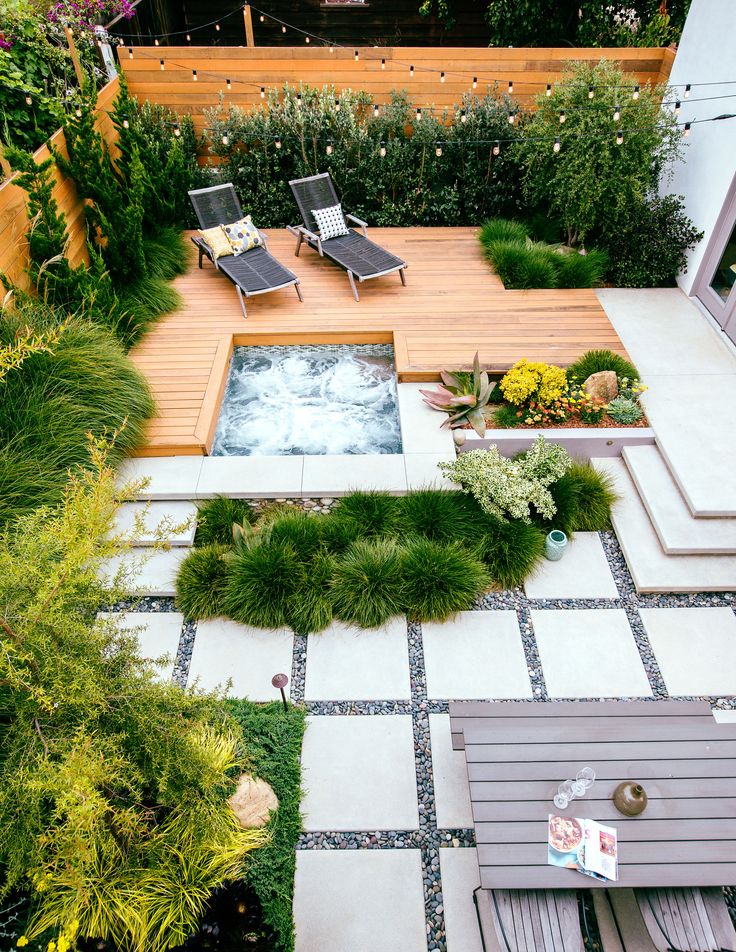
Related: 25 Amazing Plants That Are Native to North America
istockphoto.com
How to Cope with a Slope
11/11
With the right plan, even a steeply sloped backyard can be useable and enjoyable.
bobvila.com
Don't Miss!
If you have the money to hire a handyman for every household woe, go ahead. But if you want to hang on to your cash and exercise some self-sufficiency, check out these clever products that solve a million and one little problems around the house. Go now!
100 best ideas for designing a courtyard in a private house in the photo
If you are the owner of a country cottage or a private house located in the city, you understand perfectly well that the work does not end with the arrangement of your home. A lot of time, effort and money is spent on the effective and beautiful design of the territory adjacent to the house. At present, landscape design has been heard even in the most remote villages.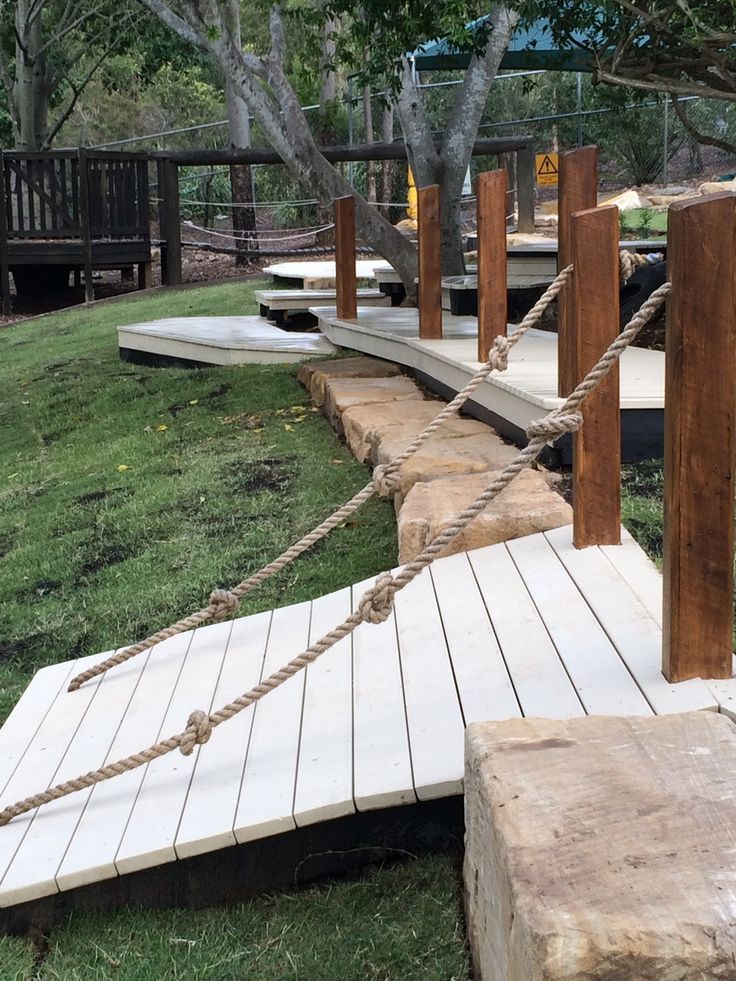 But not all of our compatriots will agree that the time of the beds laid out throughout the backyard has passed, giving way to alpine hills, fountains and artificial ponds in the oriental style.
But not all of our compatriots will agree that the time of the beds laid out throughout the backyard has passed, giving way to alpine hills, fountains and artificial ponds in the oriental style.
Most owners of private houses (both within the city and beyond) choose the option of decorating the territory adjacent to the dwelling, but with a functional background. In order for your work to be embodied in a harmonious, beautiful and practical landscape design that will delight you and your family all year round, planning must be taken seriously. Fortunately, there is more than enough information on this topic now. You can equip a private territory with a minimum of financial costs, but you will have to spend a lot of time and effort. To maintain the beauty of your site, you will need to find an opportunity and pay attention to plants, buildings, ponds and even garden furniture.
We plan the beauty of the yard
The yard around a city private house or a country cottage is an adjacent territory that welcomes not only the owners after a hard day (or a week, in the case of country estates), but also their guests.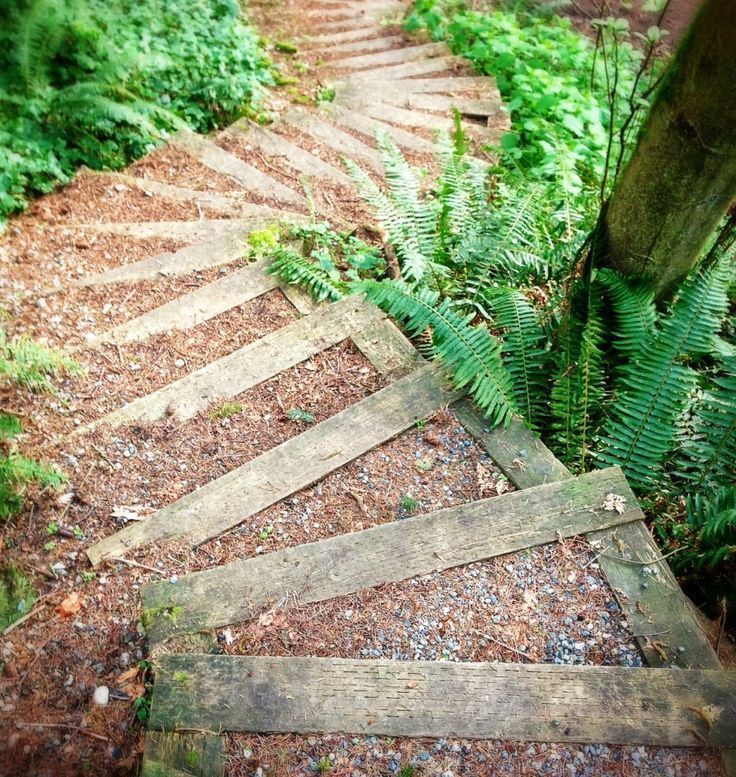 We can safely say that the impression of homeowners begins to take shape already at the first glance at the design of a personal plot or yard.
We can safely say that the impression of homeowners begins to take shape already at the first glance at the design of a personal plot or yard.
Before you start planning your landscape design, decide what "beautiful yard" means to you? How would you like to see it, is it important for you to impress your neighbors and guests with the splendor of the design of the yard, or do you put practicality and convenience at the forefront? What is your lifestyle, do you have children and pets, how often do guests gather for barbecues and barbecues, are there evening gatherings in the fresh air? In many ways, the set of "decorations" of your private yard depends on the answers to these questions. Taking into account the many nuances of the further operation of your site at the initial stage of planning, you will save not only money, but also time for subsequent alterations, reconstructions and corrections.
Of course, the landscape design of your yard will largely depend on its size.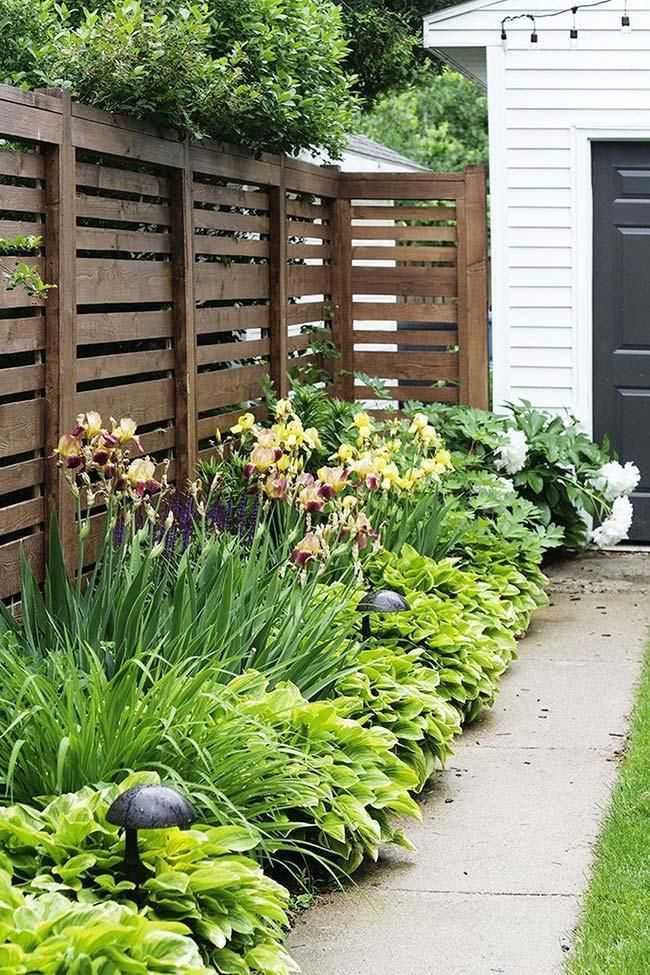 If the territory is large, then the flight of your imagination will be limited only by financial capabilities and features of the landscape of the territory, soil type and location in relation to the cardinal points. But if we are talking about a small backyard of an urban private house, then in this case it is necessary to set clear priorities. On a few square meters it will be difficult to place a playground, a barbecue area, a patio for relaxation, and a large flower bed.
If the territory is large, then the flight of your imagination will be limited only by financial capabilities and features of the landscape of the territory, soil type and location in relation to the cardinal points. But if we are talking about a small backyard of an urban private house, then in this case it is necessary to set clear priorities. On a few square meters it will be difficult to place a playground, a barbecue area, a patio for relaxation, and a large flower bed.
Having worked out the optimal plan for creating landscape design, we go to the area and mark the exact location of all objects (arbors, flower beds, rock gardens, ponds and patios). Experts recommend for simplicity to break the entire site into squares. Each such segment will have a key figure - a building or a decorative element. In this way, it is easier to evenly distribute all the conceived landscape design items and create a balanced appearance of the site.
Before starting construction work (if any), it is necessary to check the condition of the territory.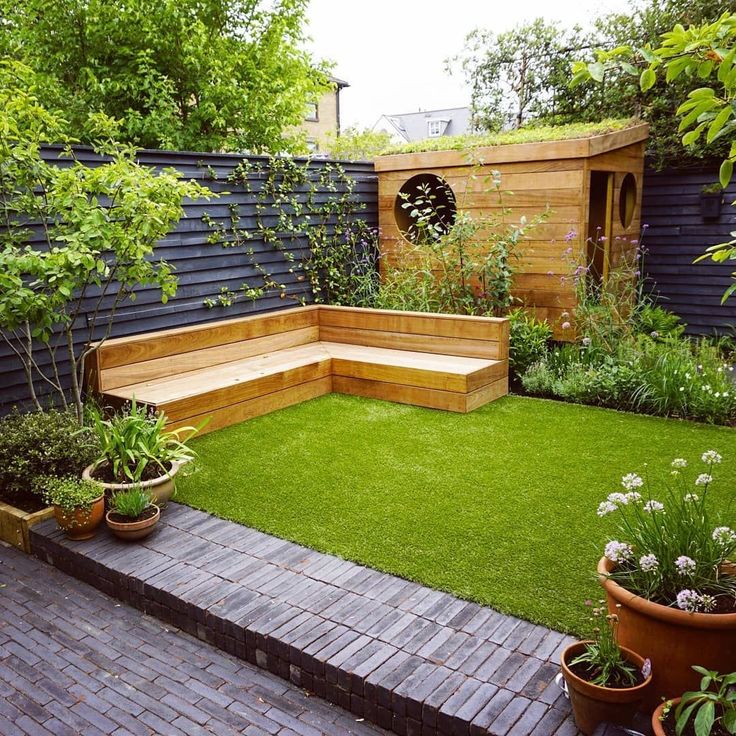 If segments of water accumulation are found, lay a drain. At the same stage, all communications necessary for watering plants and the operation of artificial reservoirs, fountains and waterfalls are laid.
If segments of water accumulation are found, lay a drain. At the same stage, all communications necessary for watering plants and the operation of artificial reservoirs, fountains and waterfalls are laid.
Paths, steps and flower beds
Garden paths are an integral part of any landscape design. In addition to its main goal - the organization of safe movement around the site, the paths perform the functions of zoning and decorating the territory.
Garden paths can be laid out from large but flat stones, concrete slabs, clinker or ordinary bricks, cobblestones, covered with fine gravel or pebbles, fencing with special low curbs. By combining the material of the tracks, you can get not only the necessary functionality, but also a decorative decoration of the garden or yard.
Landscaping and geometry are inextricably linked. For some, harmony and balance in the environment is seen in smooth lines, rounded shapes, winding paths and oval flower beds.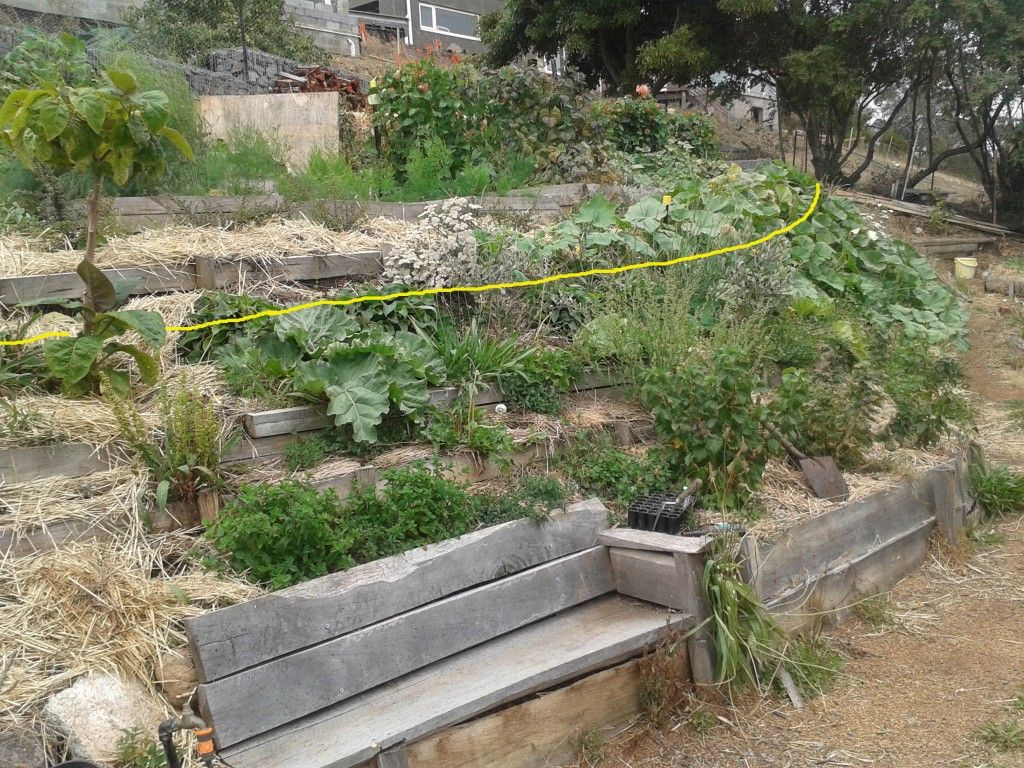 Someone needs rigor and clarity - straight garden paths, as satellites from point A to point B, strict forms of shrubs, trimmed as they say "under the ruler" and an absolutely even lawn. Only the owners know which plants and tree forms can caress their eyes and bring calm and balance to their mood.
Someone needs rigor and clarity - straight garden paths, as satellites from point A to point B, strict forms of shrubs, trimmed as they say "under the ruler" and an absolutely even lawn. Only the owners know which plants and tree forms can caress their eyes and bring calm and balance to their mood.
Planting flowers in flowerbeds or garden tubs, pots, it is better to plan in such a way that the flowering of some varieties is replaced by the flowering of other varieties. In this case, your yard will be able to delight you and your family with bright colors throughout the warm season (in most regions of our country, this is from about mid-April to early October).
If the landscape of your site suggests some hilliness, then instead of fighting nature, creating artificial embankments and leveling bevels, you can succumb to the natural arrangement of uplands and lowlands and build beautiful steps that can protrude into as a focal point, drawing everyone's attention.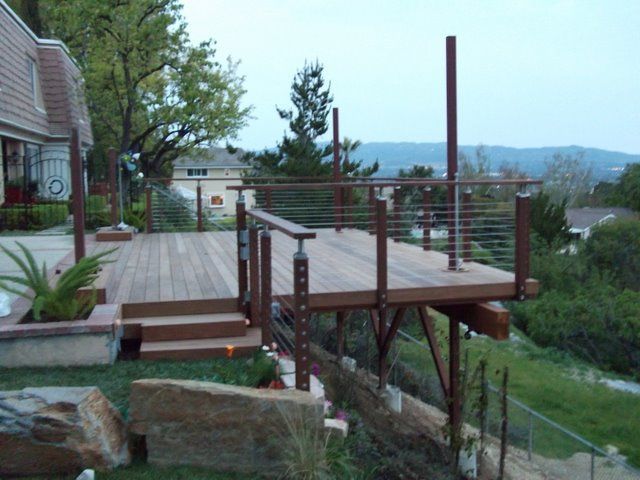
Artificial reservoirs on the site, fountains and cascades
It is rare that oriental landscape design is complete without a small artificial pond or a small source of water. And as we know, all European and American landscape designers, and our compatriots as well, draw inspiration from the founders of the art of bringing beauty and harmony to the territory surrounding the house - the Eastern peoples.
Japanese craftsmen consider water not only the source of life, but also, together with the earth, a symbol of harmony and balance of all life. It is not easy to organize an artificial reservoir on the site, you will need to contact specialists, study the features of the soil and landscape in order to choose the right place, conduct communications and subsequently tirelessly take care of the proper functioning of the fountain or cascade. But all the effort, work and money spent will pay off when you can watch the fish in your artificial pond or watch the water flow into a small tank.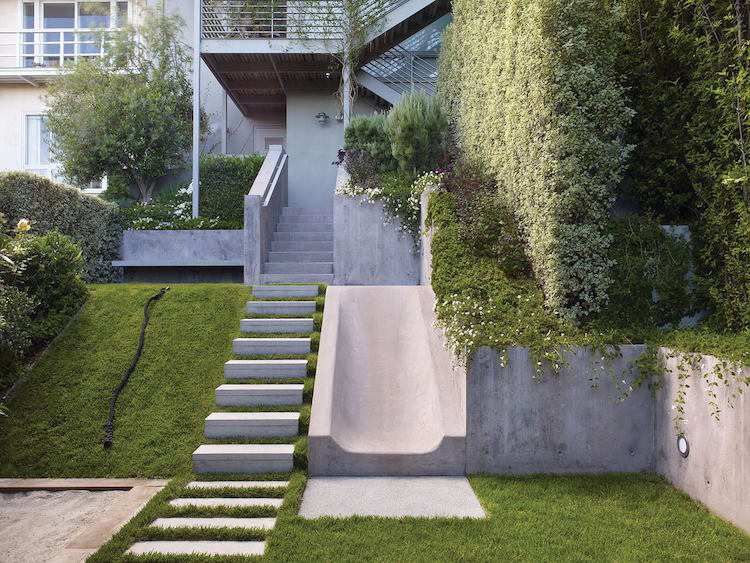
Efficient lighting system for a private courtyard
Lighting a private courtyard is not only a question of the possibility of extending the time of communication with the surrounding nature, but also the priority of safety. A well-thought-out and harmonious lighting system will allow you to calmly move around the site at night, be on the patio and enjoy the illumination of the decor items of the courtyard landscape design that are especially significant for you.
First of all, consider functional lighting - lighting the facade of the house and additional buildings, the entrance to the garage or parking lot, the main entrance. Experts recommend placing lighting fixtures in such a way that you can see the outlines of the perimeter of your yard and highlight possible ways to move around the site - garden paths, steps.
Next, you can begin to develop a plan for decorative lighting. You can create lighting near a flower bed, garden sculpture, rock garden or pond.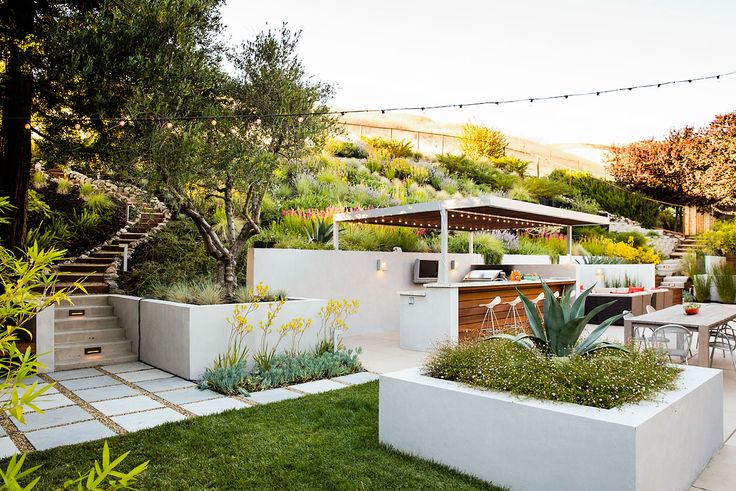 With the help of LED strips, trees and shrubs are illuminated, the so-called "illumination without lanterns".
With the help of LED strips, trees and shrubs are illuminated, the so-called "illumination without lanterns".
Lamps can be built into the spaces between the steps, but this point must be considered at the initial stage of designing the location of landscape design objects. Currently, there are many lighting devices that operate on miniature storage batteries that draw energy from sunlight. You do not have to spend money on electricity bills, the dim light of energy-saving lamps will be enough for safe movement along the paths of the site.
Resting place with hearth
Even in a small area, you can find a corner for organizing a resting place with the possibility of cooking on an open fire. Agree, it is unfair to deny yourself the opportunity to invite friends to barbecue while living in a private house with a yard, even if it is located in the city center.
The round hearth serves as an excellent focal point around which garden furniture (armchairs or small sofas) is placed, paths are formed and plants are planted.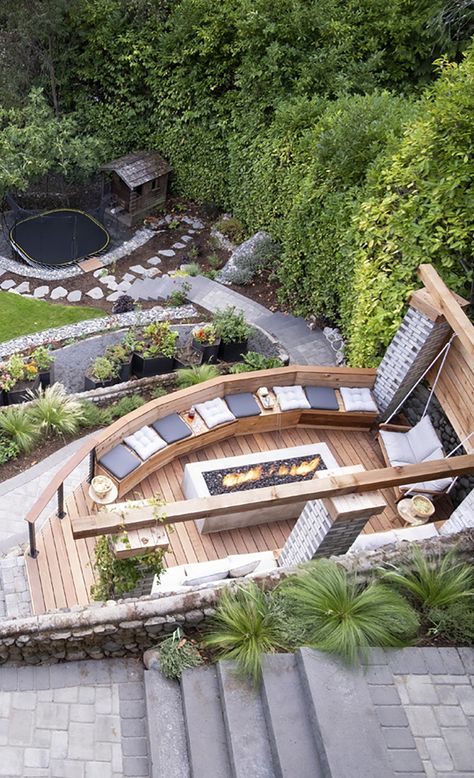 The beam layout system in this case will be the most advantageous.
The beam layout system in this case will be the most advantageous.
An outdoor fireplace or a large stone stove will not only be a functional embodiment of cooking various dishes on an open fire, but will also form a resting place where you can simply relax while watching the flame in the hearth.
Outdoor dining area or canopy
Very little space is required to set up a dining group. You just need to purchase a table and chairs (or mini-chairs) to be able to dine outdoors.
But if you have the opportunity to organize a covered canopy for the dining area on the site, then in this case, bad weather conditions cannot affect your plans. In hot weather, you and your family or guests will be protected from the sun; in rainy weather, you can safely continue lunch or dinner.
How to equip a small backyard
Very often urban private houses cannot boast of having a large surrounding area.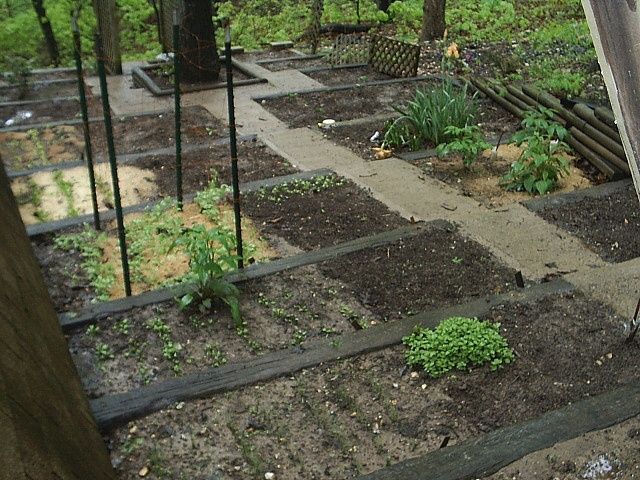 Usually in front of the house there is a place for parking a car or arranging a garage, and all areas for recreation, games and cooking in the fresh air have to be transferred to the backyard, the size of which is very limited.
Usually in front of the house there is a place for parking a car or arranging a garage, and all areas for recreation, games and cooking in the fresh air have to be transferred to the backyard, the size of which is very limited.
In this case, it is effective to place a wooden platform or deck as the basis for setting up a patio or outdoor dining area. Perennial plants in bulk beds around the perimeter of the territory or near the fence will not only decorate your backyard, but also hide your site from prying eyes.
Next, you will only have to choose garden furniture that will serve as a place to relax or dine outdoors. Outdoor furniture can be portable or stationary. Usually, stone or wooden massive furniture acts as stationary furniture, but for small courtyards without awnings, this option is not the best. It is better to give preference to folding furniture that you can hide in the pantry or in the attic with the onset of cold weather.
Nowadays, there are many garden furniture options for every taste and budget. The most popular among our compatriots is outdoor furniture made of plastic (affordable price and ease of transportation) and artificial rattan (looks respectable and expensive). But there are many models made of wood, wrought iron, stone and even bamboo. The choice of furniture for a private courtyard will depend on your financial capabilities, frequency of use and the ability to care for the furniture. For example, plastic furniture can be washed with a hose, but rattan products are very dependent on moisture. Forged chairs and tables need to be tinted every 2-3 years, and wooden furniture needs to be impregnated with oil and coated with varnish or protective antiseptics.
Add a hedge to your backyard. In addition to the main purpose - to protect the territory and protect against the penetration of strangers, the fence can also perform a decorative function. Its frame can serve as the basis for the arrangement of weaving plants, forming a combined fence, or the design of the fence itself can stand out from the general background of landscape design.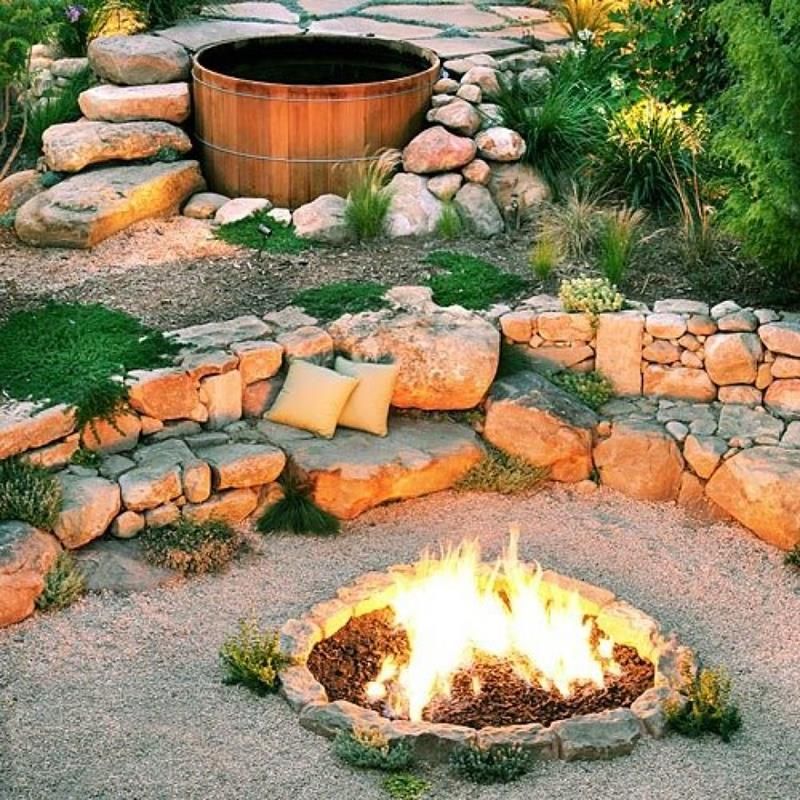
The unusual design of the fence or its bright color will bring a positive mood not only to the recreation area, but also to the entire backyard. Furniture matched to the color of the fence or soft fillings for it will create a harmonious patio with an attractive appearance.
The backyard area, in addition to the option with a wooden platform, can be laid out with concrete or stone slabs, covered with fine gravel or decorative pebbles, delineating the boundaries with low curbs or metal (polycarbonate) limiters. But in the case of loose flooring, one must be prepared for constant pouring of material and leveling it over the site.
Organizing a dining area on a wooden platform is one of the most common uses for a small backyard area. What could be better than a meal with family or in the company of friends and loved ones in the fresh air? In such an environment, appetite is better and food is tastier.
For an outdoor dining area, it is better to use light but stable furniture that you can bring under a canopy or even indoors, fold it for storage in the winter.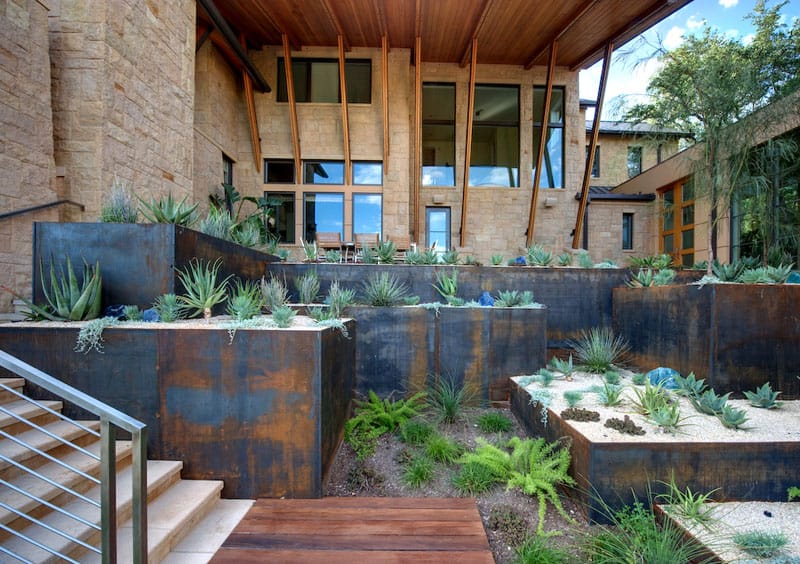 But in addition to the design and material of garden furniture, the design of products, their color and texture also matter. If the whole composition of the dining area is designed in close colors, the place for eating will delight and soothe, creating a peaceful atmosphere. If you decide to use bright, accent pieces of furniture or decor, then the atmosphere of the dining area will become tonic, charging with optimism and good mood. It all depends on the temperament of the owners of the home and the result they want to get from being in the backyard.
But in addition to the design and material of garden furniture, the design of products, their color and texture also matter. If the whole composition of the dining area is designed in close colors, the place for eating will delight and soothe, creating a peaceful atmosphere. If you decide to use bright, accent pieces of furniture or decor, then the atmosphere of the dining area will become tonic, charging with optimism and good mood. It all depends on the temperament of the owners of the home and the result they want to get from being in the backyard.
In addition to arranging a seating or dining area, the backyard can accommodate a barbecue segment. Whether it will be a stationary hearth, a portable barbecue, a real Russian stove or just a large grill - it all depends on your preferences and the size of the yard. But in any case, you will need to take care of seating near the fire and a table that will perform many functions.
tips, ideas and projects
Walking through the streets of the private sector, you involuntarily pay attention to the design of courtyards.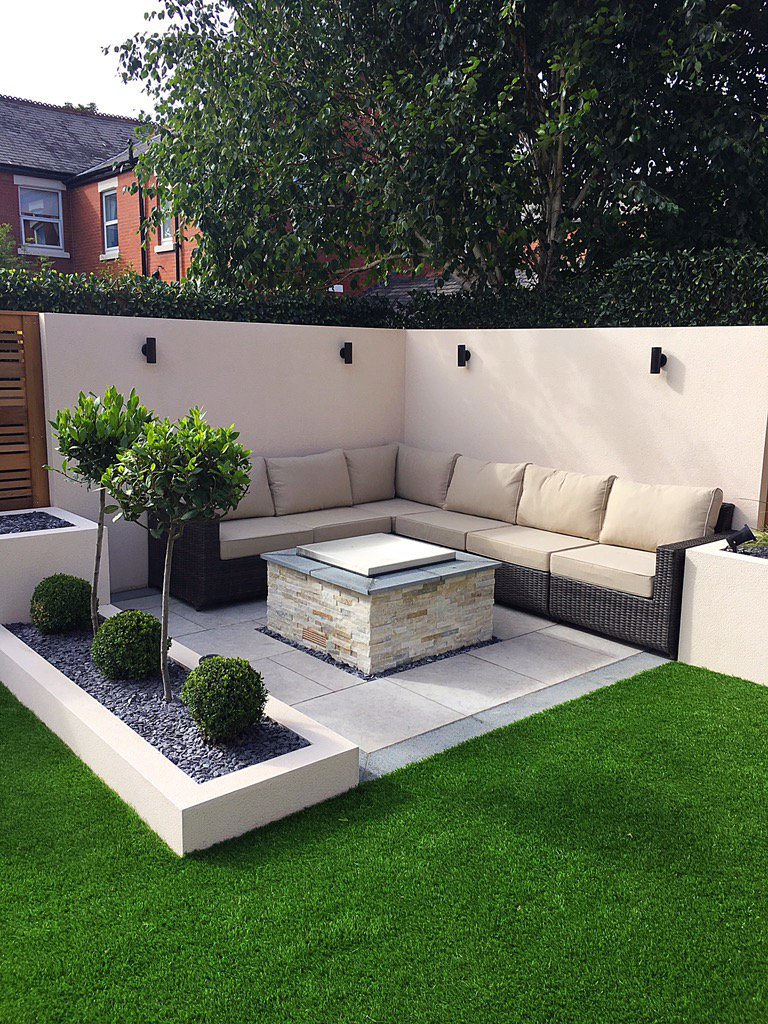 Particularly attractive are beautiful, tastefully decorated landscapes, near which you want to stay longer. Unusual compositions with artificial ponds, waterfalls, with elements of topiary, alpine slides and rockeries are interesting. Creating an extraordinary landscape in the yard requires work and knowledge of the basics of its design.
Particularly attractive are beautiful, tastefully decorated landscapes, near which you want to stay longer. Unusual compositions with artificial ponds, waterfalls, with elements of topiary, alpine slides and rockeries are interesting. Creating an extraordinary landscape in the yard requires work and knowledge of the basics of its design.
Contents
Principles for planning a yard near a private house
Courtyard - part of the land adjacent to a private house. It is divided into the front, or front yard, and back. The front yard is between the facade of the apartment building and the fence. It is open to everyone who wants to look behind the fence, and is the calling card of the owners. For this reason, its design is treated with particular scrupulousness.
The back yard is behind the house and hidden from prying eyes. A secluded resting place is arranged here, outbuildings are located, poultry and animals are kept.
The layout of the yard largely depends on the size of the plot and the needs of the family.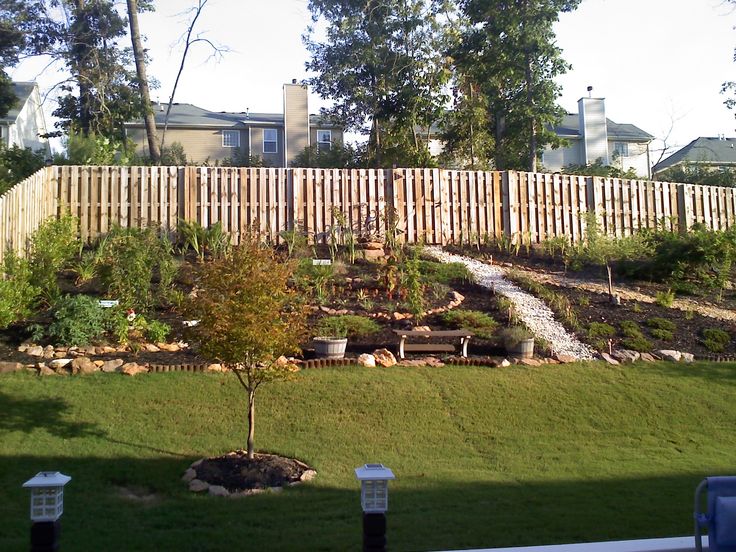 But there are general principles of its improvement, which the majority adheres to. The list of objects located on the territory of the yard includes technical buildings and decorative elements of the landscape. The first of them are a necessity, since they provide comfort to the owners of the house, and the second ones are needed to satisfy their aesthetic needs.
But there are general principles of its improvement, which the majority adheres to. The list of objects located on the territory of the yard includes technical buildings and decorative elements of the landscape. The first of them are a necessity, since they provide comfort to the owners of the house, and the second ones are needed to satisfy their aesthetic needs.
The objects of technical importance include a garage, a parking lot, a summer kitchen, a guest house, an arbor, an aviary for a dog. A garage and a parking lot are usually located just outside the gate, and other buildings are located in the depths, where road noise and street dust do not reach. An aviary or booth for a dog is arranged in a dead corner, but not too far from the outer fence.
Objects of decorative value, these are flower beds, ponds, deciduous and coniferous plantations, lawns, small architectural structures, etc. Their number depends on the area of the yard and such elements in most situations are located along the fences and walls of outbuildings.
The space directly in front of the porch is not accepted to be filled with vegetation - it must remain free for movement. On the site at the entrance to the house, tiles or other paving covering are laid.
Exception to rule. When the yard is spacious enough, flower beds are broken near the porch on the side of the steps, where flower beds do not interfere with movement.
Front yard seating area
Pergola or shed, this is common in the front yard. They are surrounded by flower beds and climbing plants, and together they make up a landscape composition.
If there is free space, you can complete the picture with any hydraulic structure: a waterfall, a fountain, an artificial pond. The proximity of water contributes to a special microclimate, especially desirable near the place of rest.
It is very popular to build a patio in front of the porch. Proximity to the front door to the house makes it possible to spend every free minute outdoors. Here you can drink a cup of morning coffee, gather with your family for evening tea or keep secrets with friends and girlfriends.
Here you can drink a cup of morning coffee, gather with your family for evening tea or keep secrets with friends and girlfriends.
On a small paved area, a table and a few chairs are set - these are the most necessary items in the arrangement of the patio area. Potted plants and sheer curtains providing light shade, comfortable wicker furniture and cushions are used to create a cozy environment.
Important. It is possible to create a full-fledged resting place on the territory of the front yard when it is isolated from the road by a blank fence or a high hedge. Otherwise, it will not be very comfortable to spend time in a sincere conversation at the sight of prying eyes. Moreover, you will not be able to relax in a hammock or on a garden sofa swing.
How to set up a backyard
Backyard design with gazebo, patio area and pond Between the house and the garden there is a space that is used in two directions: for a garage with a parking lot for a car and a resting place.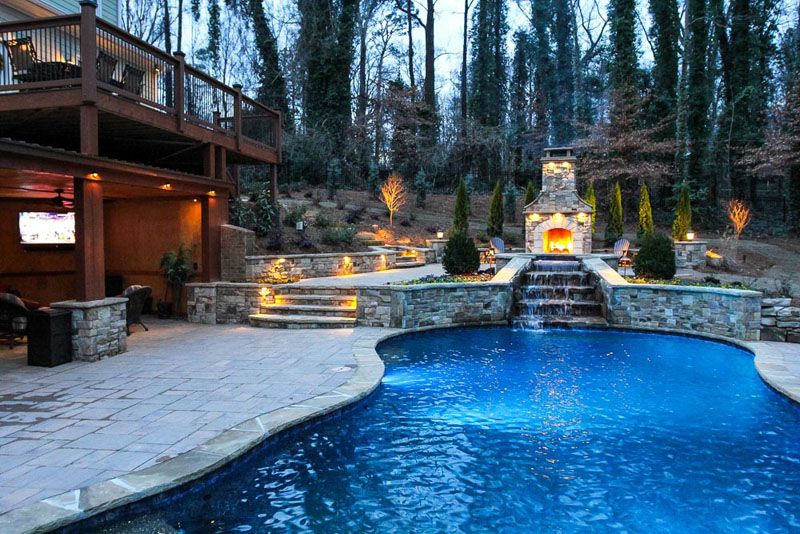 If there is enough space, you can do both by dividing it with a hedge, a vertical green screen, or a flower garden. At the same time, the garage with parking is located closer to the gate.
If there is enough space, you can do both by dividing it with a hedge, a vertical green screen, or a flower garden. At the same time, the garage with parking is located closer to the gate.
The back yard is the best place for a recreation area near a private house. It is easy to create a completely isolated space here, inaccessible to the views of neighbors and street dust. On the one hand, it is protected from the wind by the wall of the house, on the other hand by an orchard, and from the side of the neighboring plot it is separated by a fence. By constructing a light canopy, you can spend time in the backyard seating area without fear of summer rain.
This is where it is most convenient to create a barbecue area, install a barbecue or fold a garden stove.
It is also a suitable area for creating a sports ground, a place for children to play with a sandbox and swings.
Naturally, the backyard, regardless of its purpose, is decorated with various types of flower beds, it is appropriate to plant tall coniferous and deciduous trees here.
Paths and paving
A hard surface in the yard is important from a hygienic point of view. It allows you to keep the yard clean, and it is easier to take care of it: wash, remove leaves, throw away snow. Most often, continuous paving is used, when most of the yard area is laid out with paving slabs. Paths are laid from paving in different directions, helping to get to various areas: a garden, auxiliary buildings, a shower, a bathhouse, and so on.
Ford type paving is mainly used to create paths to various objects. The principle of its device is that a gap is left between the individual tiles.
At the same time, for ease of movement, the distance should not be more than 30 cm, and the tiles themselves are chosen large enough so that the foot fits completely on them. The space between the elements of this type of path is filled with lawn grass, pebbles, small gravel.
What to make paving and paths:
- Paving stones.
 Thick, brick-like tiles can easily support the weight of a car, so they are used for laying in parking lots. A blind area, a patio area, a path between the gate and the house are arranged from paving stones;
Thick, brick-like tiles can easily support the weight of a car, so they are used for laying in parking lots. A blind area, a patio area, a path between the gate and the house are arranged from paving stones; - Molded concrete tiles. Ideal for creating garden paths;
- Flagstone. Flat slabs are integrated into the lawn, combined with crushed stone filling, pebbles;
- Decking. Water resistant composite wood look. It is laid on a leveled area, sprinkled with gravel or crushed stone of small fractions. For greater reliability, decking is sometimes mounted on a crate made of timber;
- Modular cover. Plastic boards with embossed anti-slip pattern, connected with tongue-and-groove lock or foot-groove;
- Rolled plastic cover. Used to create temporary and seasonal tracks.
It is also possible to make a concrete screed with the prospect that some tile material will be laid on it in the future.
Plants in the design of the yard
Flower beds and flowerbeds help to create a special flavor around the house. The type of vegetation is selected depending on the style in which the site is designed. The size of the yard, the degree of its illumination and the design of the house are also taken into account.
Bulbous
Bulbous flowers will provide a spring explosion of colors: tulips, lilies, hazel grouses, daffodils, muscari, alliums, saffrons . Their flowering period is not very long, but many species and varieties allow you to choose plants in such a way that it lasts from April to early June. At the end of flowering, the bulbs completely wither, modestly giving way to other horticultural crops.
Conifers
Variety of shapes spruces, pines, junipers and arborvitae opens up space in the landscaping of the yard area. They are used in the creation of hedges, are present in mixborders, planted in rocky gardens and as tapeworms on green lawns. Undersized and dwarf species are popular because they are suitable for decorating small yards and are used as container crops.
Ornamental shrubs
Background plants are designed to emphasize the bright colors of beautifully flowering perennials. In this performance, 9 are of interest.0262 snowberry, privet, tamarisk, mackerel, lilac . They will cover the fence and the barn and will not divert attention from more refined plantings, such as roses, hydrangeas, peonies or irises.
Shrubs with decorative foliage and lush flowering act as dominant plants. These are Thunberg's barberry , forsythia, various types of spirea, spindle tree, viburnum buldenezh, louisiana, viburnum viburnum .
Tip. Evergreen shrubs and trees will add showiness to the flower composition: boxwood, holly mahonia, holly, cinquefoil, aucuba.
Perennials
Flower beds are based on herbaceous perennials. They define the backbone of the flower bed, around which the rest of the composition is built. For sunny places, erigeron, liatris, anemone, yucca, are suitable, and sedum and hosta grow well in the shade.
The space left between perennials is filled with annual flowers that bloom all summer.
Lianas
Liana-like plants seem to be created for decorating the yard. They braid arbors, arches, fences, porch posts. Climbing plantations are used to create green screens when zoning the garden, separating outbuildings from the front part of the yard.
Clematis in gazebo landscapingOften planted in the front garden in front of the house clematis . Their not too dense foliage transmits light well, and at the same time creates a kind of curtain that protects open windows from dust penetration.
Always in demand climbing roses , which can be planted near the porch, at the gate, at the entrance to the gazebo. Their long flowering period provides an atmosphere of conviviality throughout the summer season.
Landscape features of the yard
The total area of the land allotment does not always affect the size of the yard. Rather, how much land can be allocated to the yard depends on whether the owners plan to grow vegetables and fruits or not. If so, then on a small plot, a vegetable garden and a garden often take priority at the expense of the yard area.
Design of a small yard
It is difficult to make a large yard on a plot of 6 acres, but you can deceive the perception and expand it visually. A tiny pond will capture attention and distract from the surrounding background.
The illusion of an increase in territory will be stronger if the pond is made elongated. It is best to place it along the longest line. A similar effect of expanding space is felt in a landscape with a fountain installed on a hill.
If the allotment has an elongated shape, a small strip of land remains between the facade of the building and the fence for the front garden.
It is most practical to cover this area with paving, leaving narrow strips of earth around the perimeter along the fence for flower beds. Also suitable is the option when the flower garden is broken behind the fence. It will visually move the yard away from the road and brighten up its tightness. In such a situation, the garage takes place in the very corner, and the parking lot is also taken out of the fence.
A resting place near a house with a small yard is recommended to be arranged in the backyard. It will be easier to spend your leisure time here. The gazebo is sometimes arranged close to the house and has a common wall with it.
Yard design on a plot of 10 acres
A plot of land of 10 acres allows you to allocate about 3 acres for the front yard (but this is not a rule and depends on the location of the house on the plot). The classic option is when the house is maximally shifted to the border with neighbors, and the porch is turned towards the gate. In such a situation, on the opposite side, there is sufficient space for arranging a yard with a front garden. Not only a recreation area is arranged here. There is still enough space left to create a beautiful landscape with a mixborder, a rose garden, an alpine slide.
Since a garage is indispensable, it is taken out as close as possible to the gate: only a parking area remains between the gate and the garage.
This layout has its advantages. The building of technical importance (garage) closes the view from the street, thanks to which behind its walls you can create a full-fledged recreation area, a playground, and build a sauna.
Design of a yard on a plot of 15 acres
On a large plot of land there is a unique opportunity to build a house in the depths of the plot. The area in front of the cottage is completely at the disposal of its owners. It is divided into two main zones: an ornamental garden and a recreation area.
It is divided into two main zones: an ornamental garden and a recreation area.
The main elements of the garden are flower beds, which are located on both sides of the path leading from the gate to the porch. The design of flower beds is the most diverse, but when breaking them down, it should be taken into account that the variegation of flower beds and the piling up of many types of vegetation tires the eye. Landscape designers recommend interspersing flower beds with cut lawns and separating them with low hedges.
Uneven terrain with a rocky landscape looks original. If the site is flat and its area allows, you can artificially create elevation differences, fill them with decorative gravel and create a corner of the mountain landscape.
An artificial pond, a dry stream, wide steps on steep slopes - all these are interesting ideas for decorating a front yard.
There can be more than one recreation area in a large yard.